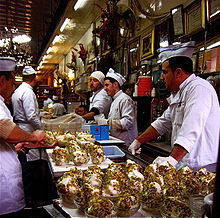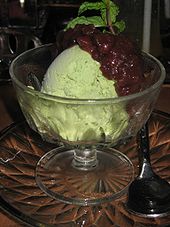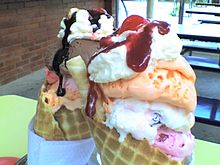- Ice cream
-
For other uses, see Ice cream (disambiguation).
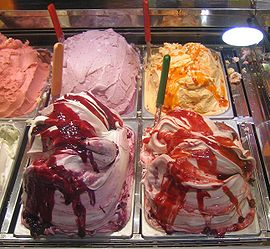
Ice cream or gelato in Rome, ItalyOrigin Alternative name(s) Gelato, sorbet, frozen custard Dish details Course served Dessert Main ingredient(s) Milk/cream, sugar Variations Strawberry, chocolate, vanilla, etc. Ice cream (formerly and properly ice-cream, derived from earlier iced cream) is a frozen dessert usually made from dairy products, such as milk and cream, and often combined with fruits or other ingredients and flavours. Most varieties contain sugar, although some are made with other sweeteners. In some cases, artificial flavourings and colourings are used in addition to, or instead of, the natural ingredients. The mixture of chosen ingredients is stirred slowly while cooling, in order to incorporate air and to prevent large ice crystals from forming. The result is a smoothly textured semi-solid foam that is malleable and can be scooped.
The meaning of the term "ice cream" varies from one country to another. Terms such as "frozen custard", "frozen yogurt", "sorbet", "gelato" and others are used to distinguish different varieties and styles. In some countries, such as the USA, the term "ice cream" applies only to a specific variety, and most governments regulate the commercial use of the various terms according to the relative quantities of the main ingredients.[1] In other countries, such as Italy and Argentina, one word is used for all variants. Analogues made from dairy alternatives, such as goat's or sheep's milk, or milk substitutes, are available for those who are lactose intolerant, allergic to dairy protein, and/or vegan.
Contents
History
Precursors of ice cream
In the Persian Empire, people would pour grape-juice concentrate over snow, in a bowl, and eat this as a treat, especially when the weather was hot. Snow would either be saved in the cool-keeping underground chambers known as "yakhchal", or taken from snowfall that remained at the top of mountains by the summer capital - Hagmatana, Ecbatana or Hamedan of today. In 400 BC, the Persians went further and invented a special chilled food, made of rose water and vermicelli, which was served to royalty during summers.[2] The ice was mixed with saffron, fruits, and various other flavours.
Ancient civilizations have served ice for cold foods for thousands of years. The BBC reports that a frozen mixture of milk and rice was used in China around 200 BC.[3] The Roman Emperor Nero (37–68) had ice brought from the mountains and combined it with fruit toppings. These were some early chilled delicacies.[4]
Arabs were perhaps the first to use milk as a major ingredient in the production of ice cream. They sweetened it with sugar rather than fruit juices, and perfected means of commercial production. As early as the 10th century, ice cream was widespread among many of the Arab world's major cities, such as Baghdad, Damascus, and Cairo. It was produced from milk or cream, often with some yoghurt, and was flavoured with rosewater, dried fruits and nuts. It is believed that the recipe was based on older Ancient Arabian, Mesopotamian, Greek, or Roman recipes, which were, it is presumed, the first and precursors to Persian faloodeh.
Maguelonne Toussaint-Samat asserts, in her History of Food, that "the Chinese may be credited with inventing a device to make sorbets and ice cream. They poured a mixture of snow and saltpetre over the exteriors of containers filled with syrup, for, in the same way as salt raises the boiling-point of water, it lowers the freezing-point to below zero."[5][6] (Toussaint does not provide historical documentation for this.) Some distorted accounts claim that in the age of Emperor Yingzong, Song Dynasty (960-1279) of China, a poem named "詠冰酪" (Ode to the ice cheese) was written by the poet Yang Wanli. Actually, this poem was named "詠酥” (Ode to the pastry; 酥 is a kind of food much like pastry in the Western world) and has nothing to do with ice cream.[7] It has also been claimed that, in the Yuan Dynasty, Kublai Khan enjoyed ice cream and kept it a royal secret until Marco Polo visited China and took the technique of making ice cream to Italy.
In the sixteenth century, the Mughal emperors used relays of horsemen to bring ice from the Hindu Kush to Delhi, where it was used in fruit sorbets.[8]
When Italian duchess Catherine de' Medici married the duc d’Orléans in 1533, she is said to have brought with her to France some Italian chefs who had recipes for flavoured ices or sorbets.[9] One hundred years later, Charles I of England was, it was reported, so impressed by the "frozen snow" that he offered his own ice cream maker a lifetime pension in return for keeping the formula secret, so that ice cream could be a royal prerogative.[10] There is no historical evidence to support these legends, which first appeared during the 19th century.
The first recipe in French for flavoured ices appears in 1674, in Nicholas Lemery’s Recueil de curiositéz rares et nouvelles de plus admirables effets de la nature.[9] Recipes for sorbetti saw publication in the 1694 edition of Antonio Latini's Lo Scalco alla Moderna (The Modern Steward).[9] Recipes for flavoured ices begin to appear in François Massialot's Nouvelle Instruction pour les Confitures, les Liqueurs, et les Fruits, starting with the 1692 edition. Massialot's recipes result in a coarse, pebbly texture. Latini claims that the results of his recipes should have the fine consistency of sugar and snow.[9]
True ice cream
Ice cream recipes first appear in 18th-century England and America. The recipe for ice cream was published in Mrs. Mary Eales's Receipts in London in 1718.[11][12]
To ice cream.
Take Tin Ice-Pots, fill them with any Sort of Cream you like, either plain or sweeten’d, or Fruit in it; shut your Pots very close; to six Pots you must allow eighteen or twenty Pound of Ice, breaking the Ice very small; there will be some great Pieces, which lay at the Bottom and Top: You must have a Pail, and lay some Straw at the Bottom; then lay in your Ice, and put in amongst it a Pound of Bay-Salt; set in your Pots of Cream, and 93 lay Ice and Salt between every Pot, that they may not touch; but the Ice must lie round them on every Side; lay a good deal of Ice on the Top, cover the Pail with Straw, set it in a Cellar where no Sun or Light comes, it will be froze in four Hours, but it may stand longer; then take it out just as you use it; hold it in your Hand and it will slip out. When you wou’d freeze any Sort of Fruit, either Cherries, Rasberries, Currants, or Strawberries, fill your Tin-Pots with the Fruit, but as hollow as you can; put to them Lemmonade, made with Spring-Water and Lemmon-Juice sweeten’d; put enough in the Pots to make the Fruit hang together, and put them in Ice as you do Cream.
The earliest reference to ice cream given by the Oxford English Dictionary is from 1744, reprinted in a magazine in 1877. 1744 in Pennsylvania Mag. Hist. & Biogr. (1877) I. 126 Among the rarities..was some fine ice cream, which, with the strawberries and milk, eat most deliciously.[13]
The 1751 edition of The Art of Cookery made Plain and Easy by Hannah Glasse features a recipe for ice cream. OED gives her recipe: H. GLASSE Art of Cookery (ed. 4) 333 (heading) To make Ice Cream..set it [sc. the cream] into the larger Bason. Fill it with Ice, and a Handful of Salt.[13]
The year 1768 saw the publication of L'Art de Bien Faire les Glaces d'Office by M. Emy, a cookbook devoted entirely to recipes for flavoured ices and ice cream.[9]
Ice cream was introduced to the United States by Quaker colonists who brought their ice cream recipes with them. Confectioners sold ice cream at their shops in New York and other cities during the colonial era. Ben Franklin, George Washington, and Thomas Jefferson were known to have regularly eaten and served ice cream. First Lady Dolley Madison is also closely associated with the early history of ice cream in the United States. One respected history of ice cream states that, as the wife of U.S. President James Madison, she served ice cream at her husband's Inaugural Ball in 1813.
Around 1832, Augustus Jackson, an African American confectioner, not only created multiple ice cream recipes but also invented a superior technique to manufacture ice cream.[14]
In 1843, Nancy Johnson of Philadelphia was issued the first U.S. patent for a small-scale handcranked ice cream freezer. The invention of the ice cream soda gave Americans a new treat, adding to ice cream's popularity. The invention of this cold treat is attributed to Robert Green in 1874, although there is no conclusive evidence to prove his claim.
The ice cream sundae originated in the late 19th century. Several men claimed to have created the first sundae, but there is no conclusive evidence to back up any of their stories. Some sources say that the sundae was invented to circumvent blue laws, which forbade serving sodas on Sunday. Towns claiming to be the birthplace of the sundae include Buffalo, New York; Two Rivers, Wisconsin; Ithaca, New York; and Evanston, Illinois. Both the ice cream cone and banana split became popular in the early 20th century. Several food vendors claimed to have invented the ice cream cone at the 1904 World's Fair in St. Louis, MO.[15] Europeans were eating cones long before 1904.[16][17]
In the UK, ice cream remained an expensive and rare treat, until large quantities of ice began to be imported from Norway and the US in the mid-Victorian era. A Swiss-Italian businessman, Carlo Gatti, opened the first ice cream stall outside Charing Cross station in 1851, selling scoops of ice cream in shells for one penny.[18]
The history of ice cream in the 20th century is one of great change and increases in availability and popularity. In the United States in the early 20th century, the ice cream soda was a popular treat at the soda shop, the soda fountain, and the ice cream parlor. During American Prohibition, the soda fountain to some extent replaced the outlawed alcohol establishments such as bars and saloons .
Ice cream became popular throughout the world in the second half of the 20th century after cheap refrigeration became common. There was an explosion of ice cream stores and of flavours and types. Vendors often competed on the basis of variety. Howard Johnson's restaurants advertised "a world of 28 flavors." Baskin-Robbins made its 31 flavours ("one for every day of the month") the cornerstone of its marketing strategy. The company now boasts that it has developed over 1000 varieties.
One important development in the 20th century was the introduction of soft ice cream. A chemical research team in Britain (of which a young Margaret Thatcher was a member)[19][20] discovered a method of doubling the amount of air in ice cream, which allowed manufacturers to use less of the actual ingredients, thereby reducing costs. It made possible the soft ice cream machine in which a cone is filled beneath a spigot on order. In the United States, Dairy Queen, Carvel, and Tastee-Freez pioneered in establishing chains of soft-serve ice cream outlets.
Technological innovations such as these have introduced various food additives into ice cream, the notable one being the stabilizing agent gluten,[21] to which some people have an intolerance. Recent awareness of this issue has prompted a number of manufacturers to start producing gluten-free ice cream.[22]
The 1980s saw a return of the older, thicker ice creams being sold as "premium" and "superpremium" varieties under brands such as Ben & Jerry's and Häagen-Dazs.
Production
Before the development of modern refrigeration, ice cream was a luxury reserved for special occasions. Making it was quite laborious; ice was cut from lakes and ponds during the winter and stored in holes in the ground, or in wood-frame or brick ice houses, insulated by straw. Many farmers and plantation owners, including U.S. Presidents George Washington and Thomas Jefferson, cut and stored ice in the winter for use in the summer. Frederic Tudor of Boston turned ice harvesting and shipping into a big business, cutting ice in New England and shipping it around the world.
Ice cream was made by hand in a large bowl placed inside a tub filled with ice and salt. This was called the pot-freezer method. French confectioners refined the pot-freezer method, making ice cream in a sorbetière (a covered pail with a handle attached to the lid). In the pot-freezer method, the temperature of the ingredients is reduced by the mixture of crushed ice and salt. The salt water is cooled by the ice, and the action of the salt on the ice causes it to (partially) melt, absorbing latent heat and bringing the mixture below the freezing point of pure water. The immersed container can also make better thermal contact with the salty water and ice mixture than it could with ice alone.
The hand-cranked churn, which also uses ice and salt for cooling, replaced the pot-freezer method. The exact origin of the hand-cranked freezer is unknown, but the first U.S. patent for one was #3254 issued to Nancy Johnson on September 9, 1843. The hand-cranked churn produced smoother ice cream than the pot freezer and did it quicker. Many inventors patented improvements on Johnson's design.
In Europe and early America, ice cream was made and sold by small businesses, mostly confectioners and caterers. Jacob Fussell of Baltimore, Maryland was the first to manufacture ice cream on a large scale. Fussell bought fresh dairy products from farmers in York County, Pennsylvania, and sold them in Baltimore. An unstable demand for his dairy products often left him with a surplus of cream, which he made into ice cream. He built his first ice cream factory in Seven Valleys, Pennsylvania, in 1851. Two years later, he moved his factory to Baltimore. Later, he opened factories in several other cities and taught the business to others, who operated their own plants. Mass production reduced the cost of ice cream and added to its popularity.
The development of industrial refrigeration by German engineer Carl von Linde during the 1870s eliminated the need to cut and store natural ice, and, when the continuous-process freezer was perfected in 1926, commercial mass production of ice cream and the birth of the modern ice cream industry was underway.
The most common method for producing ice cream at home is to use an ice cream maker, in modern times, in general, an electrical device that churns the ice cream mixture while cooled inside a household freezer, or using a solution of pre-frozen salt and water, which gradually melts while the ice cream freezes. Some more expensive models have an inbuilt freezing element. A newer method of making home-made ice cream is to add liquid nitrogen to the mixture while stirring it using a spoon or spatula. Some ice cream recipes call for making a custard, folding in whipped cream, and immediately freezing the mixture.
Commercial delivery
A bicycle-based ice cream vendor in Indonesia
Ice cream can be mass-produced and thus is widely available in developed parts of the world. Ice cream can be purchased in large cartons (vats and squrounds) from supermarkets and grocery stores, in smaller quantities from ice cream shops, convenience stores, and milk bars, and in individual servings from small carts or vans at public events. In Turkey and Australia, ice cream is sometimes sold to beach-goers from small powerboats equipped with chest freezers. Some ice cream distributors sell ice cream products from traveling refrigerated vans or carts (commonly referred to in the US as "ice cream trucks"), sometimes equipped with speakers playing children's music. Ice cream vans in the United Kingdom make a music box noise rather than actual music.
Dietary
Ice cream may have the following composition:[23]
- greater than 10% milkfat and usually between 10% and as high as 16% fat in some premium ice creams
- 9 to 12% milk solids-not-fat: this component, also known as the serum solids, contains the proteins (caseins and whey proteins) and carbohydrates (lactose) found in milk
- 12 to 16% sweeteners: usually a combination of sucrose and glucose-based corn syrup sweeteners
- 0.2 to 0.5% stabilisers and emulsifiers
- 55% to 64% water, which comes from the milk or other ingredients.
These compositions are percentage by weight. Since ice cream can contain as much as half air by volume, these numbers may be reduced by as much as half if cited by volume. In terms of dietary considerations, the percentages by weight are more relevant. Even the low-fat products have high caloric content: Ben and Jerry's No-Fat Vanilla Fudge contains 628 joule per half-cup due to its high sugar content.[24]
Ice cream around the world
Main article: Ice cream around the worldIce cream cone
Main article: Ice cream coneMrs Marshall's Cookery Book, published in 1888, endorsed serving ice cream in cones,[25] but the idea definitely predated that. Agnes Marshall was a celebrated cookery writer of her day and helped to popularise ice cream. She patented and manufactured an ice cream maker and was the first person to suggest using liquefied gases to freeze ice cream after seeing a demonstration at the Royal Institution.
Reliable evidence proves that ice cream cones were served in the 19th century, and their popularity increased greatly during the St. Louis World's Fair in 1904. According to legend, at the World's Fair an ice cream seller had run out of the cardboard dishes used to put ice cream scoops in, so they could not sell any more produce. Next door to the ice cream booth was a Syrian waffle booth, unsuccessful due to intense heat; the waffle maker offered to make cones by rolling up his waffles and the new product sold well, and was widely copied by other vendors.[26][27]
Other frozen desserts
The following is a partial list of ice cream-like frozen desserts and snacks:
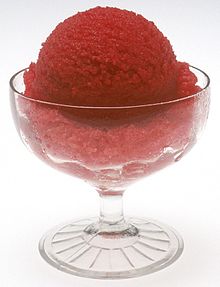 Raspberry sorbet.
Raspberry sorbet.
- Ais kacang: a dessert in Malaysia and Singapore made from shaved ice, syrup, and boiled red bean and topped with evaporated milk. Sometimes, other small ingredients like raspberries and durians are added in, too.
- Dondurma: Turkish ice cream, made of salep and mastic resin
- Frozen custard: at least 10% milk fat and at least 1.4% egg yolk and much less air beaten into it, similar to Gelato, fairly rare. Known in Italy as Semifreddo.
- Frozen yogurt: a low-fat or fat-free alternative made with yogurt
- Gelato: an Italian frozen dessert having a lower milk fat content than ice cream.
- Halo-halo: a popular Filipino dessert that is a mixture of shaved ice and milk to which are added various boiled sweet beans and fruits, and served cold in a tall glass or bowl.
- Ice milk: less than 10% milk fat and lower sweetening content, once marketed as "ice milk" but now sold as low-fat ice cream in the United States.
- Popsicle (or ice pop or lolly): frozen fruit puree, fruit juice, or flavoured sugar water on a stick or in a flexible plastic sleeve.
- Kulfi: Believed to have been introduced to South Asia by the Mughal conquest in the 16th century; its origins trace back to the cold snacks and desserts of Arab and Mediterranean cultures.[28]
- Mellorine: non-dairy, with vegetable fat substituted for milk fat
- Parevine: Kosher non-dairy frozen dessert established in 1969 in New York[29]
- Sherbet: 1–2% milk fat and sweeter than ice cream.
- Sorbet: fruit puree with no dairy products
- Snow cones, made from balls of crushed ice topped with sweet syrup served in a paper cone, are consumed in many parts of the world. The most common places to find snow cones in the United States are at amusement parks.
- Maple toffee: A popular springtime treat in maple-growing areas is maple toffee, where maple syrup boiled to a concentrated state is poured over fresh snow congealing in a toffee-like mass, and then eaten from a wooden stick used to pick it up from the snow.
Using liquid nitrogen
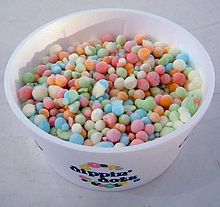 Dippin' Dots Flavored Ice Cream
Dippin' Dots Flavored Ice Cream
Using liquid nitrogen to freeze ice cream is an old idea and has been used for many years to harden ice cream. The use of liquid nitrogen in the primary freezing of ice cream, that is to effect the transition from the liquid to the frozen state without the use of a conventional ice cream freezer, has only recently started to see commercialization. Some commercial innovations have been documented in the National Cryogenic Society Magazine "Cold Facts".[30] The most noted brands are Dippin' Dots,[31] Blue Sky Creamery,[32] Project Creamery,[33] and Sub Zero Cryo Creamery.[34] The preparation results in a column of white condensed water vapor cloud, reminiscent of popular depictions of witches' cauldrons. The ice cream, dangerous to eat while still "steaming," is allowed to rest until the liquid nitrogen is completely vaporised. Sometimes ice cream is frozen to the sides of the container, and must be allowed to thaw.
Making ice cream with liquid nitrogen has advantages over conventional freezing. Due to the rapid freezing, the crystal grains are smaller, giving the ice cream a creamier texture, and allowing one to get the same texture by using less milkfat. Such ice crystals will grow very quickly via the processes of recrystallization, thereby obviating the original benefits unless steps are taken to inhibit ice crystal growth.
See also
References
- ^ "Ice Cream Labeling: What Does it all Mean?". International Foodservice Distributors Association. Archived from the original on May 14, 2008. http://web.archive.org/web/20080514083818/http://www.idfa.org/facts/icmonth/page5.cfm. Retrieved 2008-08-09.
- ^ The History of Ice Cream & The Ice Cream Cone
- ^ The origin of ice-cream, BBC. Retrieved October 26, 2009.
- ^ Andrews, Tamra (2000). Nectar and Ambrosia:An Encyclopedia of Food in World Mythology. Santa Barbara, California: ABC-CLIO. p. 121. ISBN 9781576070369. OCLC 224083021.
- ^ Toussaint-Samat, Maguelonne (2005). A history of food. translated from the French by Anthea Bell. Malden, Massachusetts: Blackwell Publishing. pp. 749–750. ISBN 9780631194972. OCLC 223367668.
- ^ Olver, Lynne (2007-09-30). "ice cream & ice". Food Timeline. http://www.foodtimeline.org/foodicecream.html. Retrieved 2008-08-09.
- ^ "詠 酥". 宋詩多媒體網路教學系統 詩文資料. http://cls.hs.yzu.edu.tw/QSS/BIN/ti_brow.asp?auid=000004&id=00011852.
- ^ Tannahill, Reay (1989). Food in History. New York: Three Rivers Press. ISBN 0-517-88404-6. OCLC 41417694 41448271 32450569 41417694 41448271.
- ^ a b c d e Powell, Marilyn (2005). Cool: The Story of Ice Cream. Toronto: Penguin Canada. ISBN 978-0-14-305258-6. OCLC 59136553. http://www.penguin.ca/nf/Book/BookDisplay/0,,0_9780143052586,00.html?sym=EXC.
- ^ Goff, H. Douglas. "Ice Cream History and Folklore". Dairy Science and Technology Education Series. University of Guelph. http://www.foodsci.uoguelph.ca/dairyedu/ichist.html. Retrieved 2008-08-09.
- ^ Eales, Mary (1985) [1718]. Mrs. Mary Eales's Receipts. London: Prospect Books. ISBN 0-907325-25-4. OCLC 228661650.
- ^ http://www.gutenberg.org/files/20735/20735-h/20735-h.htm#ice_cream "To Ice Cream" in Project Gutenberg's Mrs. Mary Eales's Receipts (1733), by Mary Eales.
- ^ a b "ice cream, n." The Oxford English Dictionary. 2nd ed. 1989. OED Online. Oxford University Press. 27 March 2008 <http://dictionary.oed.com/cgi/entry/50110937>.
- ^ Bellis, Mary. "Augustus Jackson". Inventors. About.com. http://inventors.about.com/od/ijstartinventors/a/AugustusJackson.htm. Retrieved 2008-08-09.
- ^ "Ice Cream Cone, History of Ice Cream Cone". http://whatscookingamerica.net/History/IceCream/IceCreamCone.htm. Retrieved 24 November 2009.
- ^ Weir, Robert J.. "An 1807 Ice Cream Cone: Discovery and Evidence". Historic Food. http://www.historicfood.com/Ice%20Cream%20Cone.htm. Retrieved 2008-08-09.
- ^ Stradley, Linda (2004). "History of Ice Cream Cone". What's Cooking America. http://whatscookingamerica.net/History/IceCream/IceCreamCone.htm. Retrieved 2008-08-09.
- ^ Stephens, Nick (2007-03-28). "Wine Flavoured Ice Cream". Bordeaux-Undiscovered. http://bordeaux-undiscovered.blogspot.com/2007/03/wine-flavoured-ice-cream.html. Retrieved 2009-01-04.
- ^ Margaret Thatcher
- ^ J. Lyons & Co
- ^ Pat Kendall, Ph.D., R.D. (March 31, 2003). "Gluten sensitivity more widespread than previously thought". Colorado State University Extension. http://www.ext.colostate.edu/pubs/columnnn/nn030331.html.
- ^ "Haagen-Dazs: FAQ - Is Haagen Dazs Gluten Free?". Nestlé. http://www.nestle.ca/haagen_dazs/en/Company/FAQ/index#Q13.
- ^ Goff, H. Douglas. "Ice Cream Ingredients". Dairy Science and Technology Education Series. University of Guelph. http://www.foodsci.uoguelph.ca/dairyedu/icingr.html. Retrieved 2008-08-09.
- ^ Kendall, Pat (2000-06-25). "Ice Cream - What's in a Scoop?". Colorado State University. Archived from the original on May 30, 2008. http://web.archive.org/web/20080530044709/http://www.ext.colostate.edu/pubs/columnnn/nn000725.html. Retrieved 2008-08-09.
- ^ "The Ice House - ice trade and ice cream". http://www.canalmuseum.org.uk/ice/marshall.htm. Retrieved 17 November 2009.
- ^ "Robin Weir's Ice Cream Cone Essay". Historicfood.com. 2004. http://www.historicfood.com/Ice%20Cream%20Cone.htm. Retrieved 2009-01-04.
- ^ Stradley, Linda (2004). "Ice Cream Cone, History of Ice Cream Cone". Whatscookingamerica.net. http://whatscookingamerica.net/History/IceCream/IceCreamCone.htm. Retrieved 2009-01-04.
- ^ Eater, Picky (2004). "AsianWeek". Rice Noodles in Your Frozen Delights. Pan Asia Venture Capital Corporation. Archived from the original on October 7, 2007. http://web.archive.org/web/20071007081204/http://news.asianweek.com/news/view_article.html?article_id=6d40974755251326755404c525e16478&this_category_id=171. Retrieved 2006-11-04.
- ^ Whickham, D.J.; King, H.R. 1969. "Regulation, Title 1 Agriculture and Markets, Section 39.12 Parevine; identity; label statements of ingredients." New York State Department of Agriculture and Markets (Albany, NY). Feb. 3. pp. 16–17
- ^ "Mmmm...Cryogenically Frozen Ice Cream" (PDF). Cold Facts 22 (3): 6–7. 2006. http://www.subzeroicecream.com/press/coldfacts2006.pdf.
- ^ "Dippin' Dots Ice Cream". Dippin' Dots, Inc.. 2008. http://www.dippindots.com/.
- ^ "Blue Sky Creamery". Blue Sky Creamery, Inc.. 2008. http://www.blueskycreamery.com.
- ^ "Project Creamery". Project Creamery, Inc.. 2008. http://www.projectcreamery.com/.
- ^ "Sub Zero Ice Cream". Sub Zero Ice Cream. 2004. http://www.subzeroicecream.com/.
External links
- How It’s Made: UConn Dairy Bar Ice Cream
- Selected Internet Resources --Ice Cream / Science Reference Section, Library of Congress
- History of Ice Cream
- Another History of Iced Beverages and Ice Cream
- Ice Cream sculptures
- Ice Cream Reviews
- The Complete Guide To Ice Cream
- Ice cream history and "who really invented the ice cream cone?"
- Cooking with Chemistry, Liquid Nitrogen Ice Cream
- HowStuffWorks's How Ice-Cream Works.
- Popular culture, Laurel & Hardy Sketch
- The Structure of Ice Cream
Categories:- Ice cream
- Dairy products
- Desserts
- Frozen desserts
- Italian cuisine
- French cuisine
- British cuisine
- American cuisine
- World cuisine
Wikimedia Foundation. 2010.

